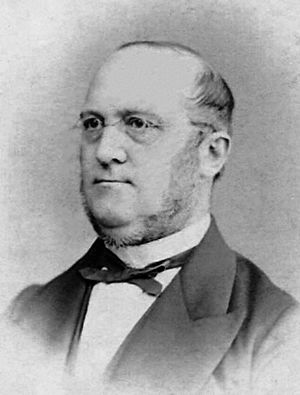Hermann Kolbe facts for kids
Quick facts for kids
Hermann Kolbe
|
|
|---|---|

Hermann Kolbe
|
|
| Born | 27 September 1818 Elliehausen, near Göttingen, Kingdom of Hanover
|
| Died | 25 November 1884 (aged 66) |
| Nationality | German |
| Alma mater | University of Marburg |
| Known for | Kolbe electrolysis, Kolbe–Schmitt reaction Kolbe nitrile synthesis |
| Awards | Davy Medal (1884) ForMemRS (1877) |
| Scientific career | |
| Fields | Chemist |
| Institutions | University of Marburg University of Leipzig |
| Doctoral advisor | Robert Bunsen Friedrich Wöhler |
| Doctoral students | Peter Griess Aleksandr Mikhailovich Zaitsev Theodor Curtius Ernst Otto Beckmann Carl Graebe Oscar Loew Constantin Fahlberg Nikolai Menshutkin Vladimir Markovnikov Jacob Volhard Ludwig Mond Alexander Crum Brown Maxwell Simpson Frederick Guthrie [Note, not primary advisor for all in this list] |
Adolph Wilhelm Hermann Kolbe (born September 27, 1818 – died November 25, 1884) was an important chemist. He helped create modern organic chemistry. He taught at the University of Marburg and Leipzig University.
Kolbe was the first to use the word "synthesis" in chemistry. He helped disprove the idea of "vitalism". This was a belief that organic chemicals could only come from living things. Kolbe showed that acetic acid, an organic substance, could be made from carbon disulfide.
He also helped develop ideas about how chemicals are structured. He predicted new types of alcohols. Kolbe developed important chemical reactions. These include Kolbe electrolysis, the Kolbe–Schmitt reaction (used to make aspirin), and the Kolbe nitrile synthesis.
Kolbe studied with famous chemists like Friedrich Wöhler and Robert Bunsen. He worked in London, helping to connect chemists internationally. He received important awards like the Davy Medal. Kolbe also taught many future chemists.
Later in his life, Kolbe edited a chemistry journal. He was very critical of other chemists' ideas. He strongly disagreed with theories about the structure of benzene and chirality. Kolbe died in Leipzig at age 66. He had four children.
Contents
Life of Hermann Kolbe
Kolbe was born in Elliehausen, near Göttingen, Germany. He was the oldest son of a Protestant pastor. When he was 13, he went to a good school in Göttingen. He lived with one of the professors there.
He finished school six years later. Kolbe became very interested in chemistry. In 1838, he started studying at the University of Göttingen. He learned from the famous chemist Friedrich Wöhler.
Early Career and Studies
In 1842, Kolbe became an assistant to Robert Bunsen. This was at the Philipps-Universität Marburg. He earned his doctoral degree there in 1843. A new chance came in 1845. He became an assistant to Lyon Playfair. This was at a new museum in London. He also became good friends with Edward Frankland.
From 1847, Kolbe helped edit a big chemistry dictionary. It was called Handwörterbuch der reinen und angewandten Chemie. He also wrote an important textbook. In 1851, Kolbe took over from Bunsen as a chemistry professor at Marburg. In 1865, he moved to Leipzig University.
Awards and Family Life
In 1864, he became a foreign member of the Royal Swedish Academy of Sciences. He was also chosen as a member of the American Philosophical Society in 1874.
In 1853, Kolbe married Charlotte. She was the daughter of General-Major Wilhelm von Bardeleben. His wife died in 1876. They had been married for 23 years. They had four children together.
Kolbe's Chemical Discoveries
In the 1840s, some chemists still believed in vitalism. This idea said that a special "life-force" was needed to create "organic" compounds. Organic compounds originally meant those from living things.
Kolbe showed that organic compounds could be made from non-living things. He did this by changing carbon disulfide (CS2) into acetic acid (CH3COOH). This took several steps between 1843 and 1845. This work helped to disprove the idea of vitalism.
Structural Theory and New Reactions
Kolbe also changed the idea of radicals. This helped develop structural theory in chemistry. A big success was when he predicted new types of alcohols. These were called secondary and tertiary alcohols. His predictions were later proven correct.
Kolbe was the first to use the word "synthesis" in its modern meaning. He also created several new chemical reactions.
He developed ways to use electrolysis on salts of fatty and other carboxylic acids. This is known as Kolbe electrolysis. He also prepared salicylic acid, which is used to make aspirin. This process is called the Kolbe synthesis or Kolbe–Schmitt reaction. His method for making nitriles is called the Kolbe nitrile synthesis. With Edward Frankland, he found that nitriles could be changed into acids.
Teaching and Mentoring
Besides his own research, Kolbe guided many students. He taught at Leipzig and Marburg. Some of his famous students included:
- Peter Griess
- Aleksandr Mikhailovich Zaitsev (known for Zaitsev's rule)
- Theodor Curtius (discovered diazo compounds)
- Ernst Otto Beckmann (discovered the Beckmann rearrangement)
- Carl Graebe (discovered alizarin)
- Vladimir Markovnikov (known for Markovnikov's rule)
- Ludwig Mond
Work as a Journal Editor
Kolbe was the main editor of the Journal für Praktische Chemie for over ten years. He edited it from 1870 to 1884. Kolbe was sometimes very critical of other chemists' work. This was especially true after 1874.
He did not like what he saw as wild guesses pretending to be scientific theories. He wanted to protect chemistry from what he thought were bad modern ideas about structure. He strongly disagreed with the ideas of August Kekulé about benzene's structure. He also disagreed with J.H. van't Hoff's theory about asymmetric carbon atoms. Kolbe also opposed Adolf von Baeyer's changes to chemical names. He wrote very strong articles in his journal about these disagreements. His strong opinions sometimes made it harder for people to appreciate his work after he died.
See also
 In Spanish: Adolph Wilhelm Hermann Kolbe para niños
In Spanish: Adolph Wilhelm Hermann Kolbe para niños

